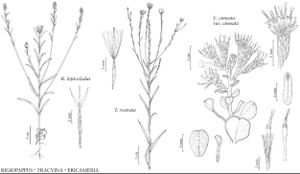Rigiopappus
Proc. Amer. Acad. Arts 6: 548. 1865.
| Taxon | Illustrator ⠉ | |
|---|---|---|
 | Rigiopappus leptocladus Tracyina rostrata Ericameria cuneata var. cuneata | Yevonn Wilson-Ramsey Yevonn Wilson-Ramsey John Myers |
Annuals, 5–30+ cm (taprooted). Stems usually erect, simple or branched (laterals often overtopping main-stems), pilosulous to hirtellous, glabrate. Leaves mostly cauline (at flowering); alternate; ± sessile; blades (1-nerved or 3-nerved) narrowly oblanceolate to lance-linear or linear, margins entire, faces glabrous or sparsely hirsutulous. Heads radiate, borne singly. Involucres ± cylindric to turbinate, 1–3 (–5+) mm diam. Phyllaries 11–20+ in 2+ series, 1-nerved (flat) linear to lanceolate or subulate, subequal (distinct), herbaceous, margins scarious, faces hirsutulous (± navicular, each of the inner usually ± enfolding a floret). Receptacles ± flat, obscurely pitted, sparsely paleate (between ray and disc-florets, paleae resembling inner phyllaries). Ray-florets 3–13+ (usually 3, 5, or 8), pistillate, fertile; corollas yellowish, often tinged with red or purple (laminae inconspicuous). Disc-florets 5–70+, bisexual, fertile; corollas pale-yellow, sometimes tipped with purple, tubes shorter than narrowly funnelform throats, lobes 2–4, erect, ± deltate; style-branch appendages subulate to filiform. Cypselae ± cylindric to fusiform, little, if at all, compressed, transversely rugulose, all minutely hirsutulous or ray cypselae glabrous or nearly so; pappi persistent, usually of 3–5 subulate scales (sometimes much reduced or 0 on ray cypselae). x = 9.
Distribution
w North America
Discussion
Species 1.